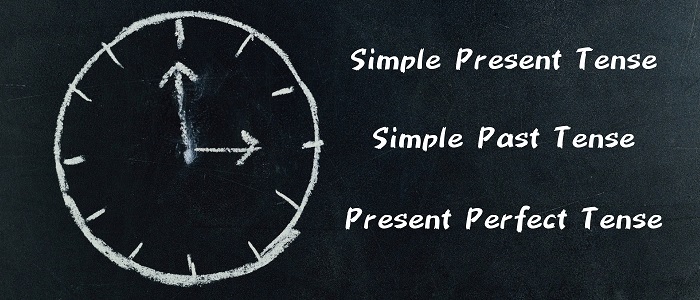




Quick Takeaways:
The English language has a rich history of borrowing words from other languages, especially from Latin. Latin abbreviations such as ‘a.m.’, ‘p.m.’ and ‘CV’ have become part of our everyday vocabulary. Such abbreviations are also frequently used in academic writing, from the ‘Ph.D.’ in the affiliation section to the ‘i.e.’, ‘e.g.’, ‘et al.’, and ‘QED’ in the rest of the paper.
This guide explains when and how to correctly use ‘et al.’ in a research paper.
如能在你的论文中使用到适当的动词时态 (verb tense),将可以令你的写作更清晰及更易被读懂。但是这一点都不简单,很多时连母语为英语的人都未必能够弄清楚呢!
而且更複杂的是不同学科对动词时态的使用都有不同要求!
当你明白使用不同时态的目的以及其背后原因,这个问题其实并不是很困难,放心吧!
现在请一起看一看3种在学术写作中最常用的动词时态,并透过一些例子了解应该在什麽时候使用该时态及为什麽选择用它。

在一般学术写作中,除了在如商科或会计科中,现在时相对於过去时是比较少用的。
它多数是用於:
1. 形容事实及一般法则,更多是在引言部分陈述关於研究题目的背景资料。例如:
“The Reynolds number provides a measure of…”
上面句子中的Reynolds number 是一个在流体动力学中重要的无因次质量,用作预测在不同流体流动情况中的流动模式。它在该学科中被定义为一般法则。
2. 形容该论文中的内容或引用图表等。例如:
“Section 3 presents the results”
“Table 2 above demonstrates the success…”
一般过去时是用作形容在已过去的某一时间点发生的事物。
所以,当引述评论一些文献或过去的研究时,你会这样写:
“Smith and Olson (2009) reported that…”
“The subjects in the first group scored higher, on average…”
现在完成时用於:
1. 形容一些由过去连繫到现在或仍在继续的事件。例如:
“Mobile phone use has increased over the past decade”
2. 形容一般结果时强调什麽已经做了,但要留意这里说的不是一些早已被认知的真理。例如:
“Researchers have used this material to manufacture…”
以上提到的都是你在写作论文引言时将会经常使用到的时态,你可以多参考上述的例子。另外,你写作时还需要注意以下两点。
留意下面同一句子当在使用过去时及现在时,其表达的意思是有所不同:
“The temperature increased linearly over time” 是在引述某一實驗。 但當使用了現在式時,
“The temperature increases linearly over time” 是在歸納觀察結果,提出溫度上升與時間保持線性關係。
在複杂的句子中,你可以组合使用过去时及现在时。
例如:
“In 1905, Albert Einstein postulated that the speed of light is constant”
在这里,postulated 是在过去发生的,所以用了过去时,但 is 所表达的是一般法则,固用上了现在时。
切记语言运用在不同学科中都会有些许变化,所以要查阅你将要投稿的期刊的其他已发表论文是如何撰写的,因为以你的论文所在的学科的一贯语言运用风格去写你的论文是最为重要的。
Wondering why some abbreviations such as ‘et al.’ and ‘e.g.’ use periods, whereas others such as CV and AD don’t? Periods are typically used if the abbreviations include lowercase or mixed-case letters. They’re usually not used with abbreviations containing only uppercase letters.
Our latest online workshop built on the success of face-to-face workshops we developed specifically for local universities. Over 30 faculty members joined the session, presented by our Chief Operating Officer, Mr Nick Case, to learn from our case studies on editing research proposals.
The response to our workshop, which included a constructive and insightful Q&A session, was very positive.Drawing on our extensive experience working with hundreds of Hong Kong researchers targeting the GRF and ECS every year, we used examples of poor and subsequently improved proposals to show the attendees how they can make their applications stand out. The response to our workshop, which included a constructive and insightful Q&A session, was very positive.Drawing on our extensive experience working with hundreds of Hong Kong researchers targeting the GRF and ECS every year, we used examples of poor and subsequently improved proposals to show the attendees how they can make their applications stand out. The response to our workshop, which included a constructive and insightful Q&A session, was very positive.Drawing on our extensive experience working with hundreds of Hong Kong researchers targeting the GRF and ECS every year, we used examples of poor and subsequently improved proposals to show the attendees how they can make their applications stand out.

Wondering why some abbreviations such as ‘et al.’ and ‘e.g.’ use periods, whereas others such as CV and AD don’t? Periods are typically used if the abbreviations include lowercase or mixed-case letters. They’re usually not used with abbreviations containing only uppercase letters.
Check out AsiaEdit’s professional research grant proposal editing service.
Read more about our training services covering all aspects of academic writing tailored for local institutions.
More resources on research grant proposal writing: On-demand Webinars
Preparing an effective research proposal – Your guide to successful funding application
Preparing an effective research proposal – Your guide to successful funding application (Part 2)

Rachel于2001年刚在University of Exeter 取得博士学位的同时,以自由编辑的身份首次加入我们。在担任博士后研究人员数年之后,她专注于大学教授心理学,并于2010年回到AsiaEdit,并专注于学术编辑专业。她于2018年升任助理总编辑,并于2020年继而成为我们的联合主编。由于无法完全离开学术界,她还在意大利的一所英语大学教授心理学。
你的日程安排,我们最关切 AsiaEdit采用个性化的润色方式。
香港湾仔
轩尼诗道99号2101室
9:00am – 6:00pm
(+852) 2590 6588
